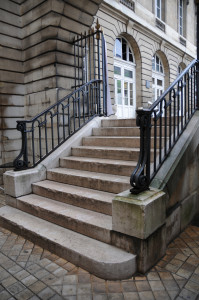As you know, the title of one of my books will be “Where Did They Put the Guillotine?” It’s about buildings, places, sites and people significant to the French Revolution. I’ll take you on walking tours of Paris and show you these sites. One of the walking tours will be entitled: “The Rumble of the Tumbrel: Marie Antoinette’s Last Ride.”

So on our recent trip to Paris, we decided to walk the exact route that Marie Antoinette’s tumbrel (i.e., cart) took to the guillotine.
We began at the Conciergerie, the former medieval palace turned prison. Prisoners were brought here from other prisons scattered around Paris. This was their last stop before getting into the tumbrels that would take them to the guillotine. A typical stay was one or two nights. Marie Antoinette was an exception as she spent over two months in this prison. Once the bell rang (it is still there), the condemned prisoners would congregate in the “Corner of the Twelve” before being loaded into the carts (each cart could hold twelve people ergo the name of the segregated courtyard).


